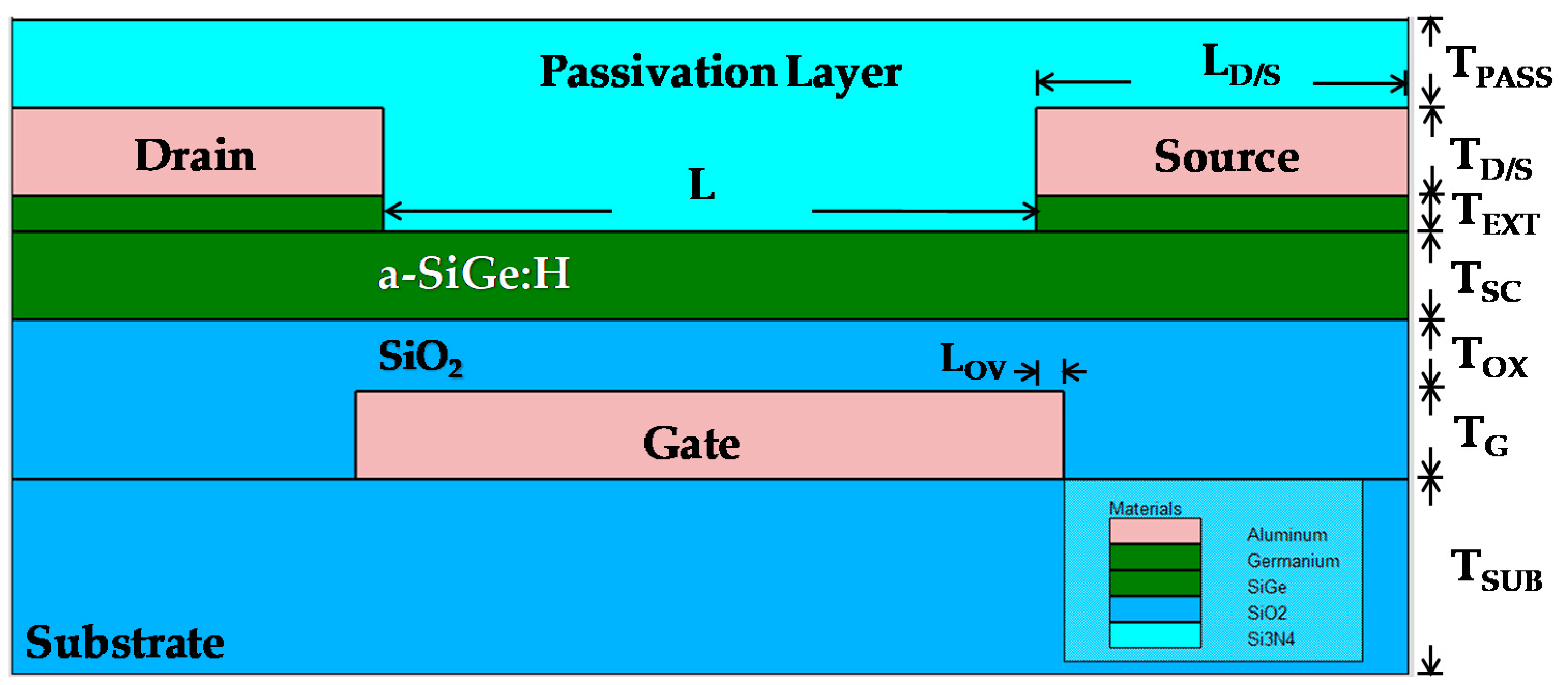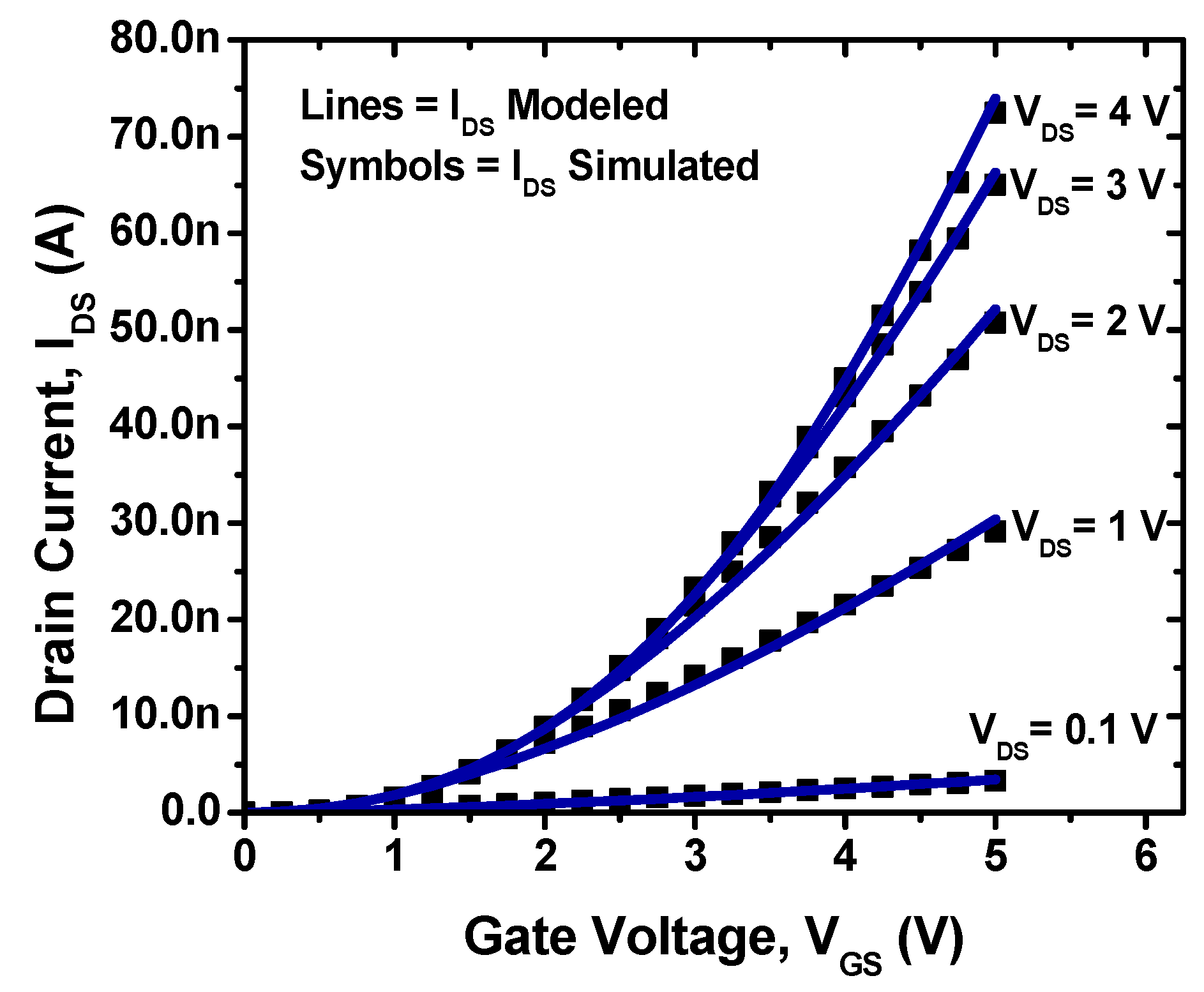Analytical Drain Current Model for a-SiGe:H Thin Film Transistors Considering Density of States
Abstract
1. Introduction
2. Analytical Drain Current Model for a-SiGe:H TFTs
2.1. Density of Estates of Amorphous Semiconductors
2.2. Analytical Drain Current Model
2.2.1. Derivation of Electric Field
2.2.2. Derivation of Drain to Source Current in Subthreshold Region, IDS_sub
2.2.3. Derivation of Drain Current at Above Threshold Region, IDS_abv
2.2.4. Total Analytical Drain Current Model
3. Results and Discussion
4. Conclusions
Author Contributions
Funding
Acknowledgments
Conflicts of Interest
Appendix A
References
- Gao, X.; Lin, L.; Liu, Y.; Huang, X. LTPS TFT Process on Polyimide Substrate for Flexible AMOLED. IEEE J. Disp. Tech. 2015, 11, 666–669. [Google Scholar] [CrossRef]
- Xu, X.; Huang, B.; Fan, J.; Zhao, J.; Guo, X. Employing Drain-Bias Dependent Electrical Characteristics of Poly-Si TFTs to Improve Gray Level Control in Low Power AMOLED Displays. IEEE J. Elec. Devices Soc. 2019, 7, 489–494. [Google Scholar] [CrossRef]
- Lin, C.L.; Lai, P.C.; Lee, P.T.; Chen, B.S.; Chang, J.H.; Lin, Y.S. Highly Reliable a-Si: H TFT Gate Driver With Precharging Structure for In-Cell Touch AMLCD Applications. IEEE Trans. Elect. Devices 2019, 66, 1789–1796. [Google Scholar] [CrossRef]
- Wang, X.; Liu, Z.; Zhang, T. Flexible Sensing Electronics for Wearable/Attachable Health Monitoring. Small 2017, 13, 1602790. [Google Scholar] [CrossRef] [PubMed]
- Han, S.T.; Peng, H.; Sun, Q.; Venkatesh, S.; Chung, K.S.; Lau, S.C.; Zhou, Y.; Roy, V.A.L. An Overview of the Development of Flexible Sensors. Adv. Mat. 2017, 33, 1700375. [Google Scholar] [CrossRef] [PubMed]
- Fiore, V.; Battiato, P.; Abdinia, S.; Jacobs, S.; Chartier, I.; Coppard, R.; Klink, G.; Cantatore, E.; Ragonese, E.; Palmisano, G. An Integrated 13.56-MHz RFID Tag in a Printed Organic Complementary TFT Technology on Flexible Substrate. IEEE Trans. Circuits Syst. I Regul. Pap. 2015, 62, 1668–1677. [Google Scholar] [CrossRef]
- Mehlman, Y.; Kumar, P.; Ozatay, M.; Wagner, S.; Sturm, J.C.; Verma, N. Large-Area Electronics HF RFID Reader Array for Object-Detecting Smart Surfaces. IEEE Solid-State Circuits Lett. 2018, 1, 182–185. [Google Scholar] [CrossRef]
- Qin, Y.; Li, G.; Xu, Y.; Chen, R.; Deng, S.; Zhong, W.; Kwok, H.S. Low-Power Design for Unipolar ITO-Stabilized ZnO TFT RFID Code Generator Using Differential Logic Decoder. IEEE Trans. Electron Devices 2019, 66, 4768–4773. [Google Scholar] [CrossRef]
- Huang, Y.; Hekmatshoar, B.; Wagner, S.; Sturm, J.C. Top-Gate Amorphous Silicon TFT With Self-Aligned Silicide Source/Drain and High Mobility. IEEE Electron Device Lett. 2008, 29, 737–739. [Google Scholar] [CrossRef]
- Hu, H.H.; Huang, H.P. High-Frequency Performance of Trigate Poly Si Thin-Film Transistors by Microwave Annealing. IEEE Electron Device Lett. 2015, 36, 345–347. [Google Scholar] [CrossRef]
- Park, J.H.; Jang, G.S.; Kim, H.Y.; Lee, S.K.; Joo, S.K. High-Performance Poly-Si Thin-Film Transistor With High-k ZrTiO4 Gate Dielectric. IEEE Electron Device Lett. 2015, 36, 920–922. [Google Scholar] [CrossRef]
- Chen, Y.-J.E.; Lee, Y.-J.; Yu, Y.-H. Investigation of Polysilicon Thin-Film Transistor Technology for RF Applications. IEEE Trans. Microw. Theory Tech. 2010, 58, 3444–3451. [Google Scholar] [CrossRef]
- Wang, Y.; Yang, J.; Wang, H.; Zhang, J.; Li, H.; Zhu, G.; Song, A. Amorphous-InGaZnO Thin-Film Transistors Operating Beyond 1 GHz Achieved by Optimizing the Channel and Gate Dimensions. IEEE Trans. Electron. Devices 2018, 65, 1377–1382. [Google Scholar] [CrossRef]
- Hsu, S.-M.; He, J.-C.; Li, Y.-S.; Su, D.-Y.; Tsai, F.-Y.; Cheng, I.-C. Effect of Mechanical Strain on Electrical Performance of Flexible P-Type SnO Thin-Film Transistors. IEEE Trans. Electron Devices 2019, 66, 5183–5186. [Google Scholar] [CrossRef]
- Dominguez, M.; Rosales, P.; Torres, A.; Moreno, M.; Molina, J.; de la Hidalga, F.; Calleja, W. Ambipolar a-SiGe:H thin-film transistors fabricated at 200 °C. J. Non-Cryst. Solids 2012, 358, 2340–2343. [Google Scholar] [CrossRef]
- Shur, M.S. SPICE Models for Amorphous Silicon and Polysilicon Thin Film Transistors. J. Electrochem. Soc. 1997, 144, 2833. [Google Scholar] [CrossRef]
- Chen, S.S.; Kuo, J.B. An analytical a-Si:H TFT DC/capacitance model using an effective temperature approach for deriving a switching time model for an inverter circuit considering deep and tail states. IEEE Trans. Electron. Devices 1994, 41, 1169–1178. [Google Scholar] [CrossRef]
- Liu, Y.; Yao, R.H.; Li, B.; Deng, W.L. An Analytical Model Based on Surface Potential for a-Si:H Thin-Film Transistors. J. Disp. Technol. 2008, 4, 180–187. [Google Scholar] [CrossRef]
- Colalongo, L. A new analytical model for amorphous-silicon thin film transistor including tail and deep states. Solid State Electron. 2001, 45, 1525–1530. [Google Scholar] [CrossRef]
- Rosales-Quintero, P.; Torres-Jacome, A.; Murphy-Arteaga, R.; Landa-Vázquez, M. Electrical characterization of n-type a-SiGe:H/p-type crystalline-silicon heterojunctions. Semicond. Sci. Techn. 2003, 19, 366–372. [Google Scholar] [CrossRef]
- Silvaco International. Atlas User’s Manual. Available online: www.silvaco.com (accessed on 18 September 2019).





| Name | Parameter | a-SiGe:H | SiO2 |
|---|---|---|---|
| Permittivity | ɛ | 11.8 | 3.9 |
| Electronic affinity | Χ | 4.01 eV | 0.9 eV |
| Bandgap | Eg | 1.4 eV | 9 eV |
| Intrinsic concentration | ni | 1 × 1012 cm–3 | - * |
| Conduction band density | Nc | 1 × 1020 cm–3 | - * |
| Valence band density | Nv | 1 × 1020 cm–3 | - * |
| Electron band mobility | μ0 | 0.56 cm2/Vs | - * |
| Bulk Fermi Level | ΦF0 | 0.56 V | - * |
| Flat band voltage | VFB | −0.01 V | - * |
| Name | Parameter | Value |
|---|---|---|
| Zero bias density of states acceptor for tail state | gTA | 1 × 1020 |
| Zero bias density of states acceptor for deep state | gGA | 2 × 1016 |
| Degeneration factor | G | 2 |
| Correlation energy | U=EGA – EGD | 0.3 eV |
| Acceptor characteristic decay energy for deep state | WGA | 0.3 eV |
| Donor characteristic decay energy for deep state | WGD | 0.3 eV |
| Acceptor density distribution for deep state | NGA | 2 × 1016 cm–3 |
| Donor density distribution for deep state | NGD | 2 × 1016 cm–3 |
| Acceptor density distribution for tail state | NTA | 1 × 1020 |
| Acceptor density distribution for deep state | NTD | 1 × 1020 |
| Reference characteristic temperature | T | 182.8 K |
| Free characteristic temperature | Tfree | 300 K |
| Deep state characteristic temperature | Tdeep | 649.8 K |
| Tail state characteristic temperature | Ttail | 324.92 K |
| Acceptor characteristic decay energy tail state | WTA | 0.028 eV |
| Donor characteristic decay energy for tail state | WTD | 0.056 eV |
| Electron capture cross-section for the donor gaussian state | SIGGDE | 1.3 × 10–14 |
| Electron capture cross-section for the acceptor gaussian state | SIGGAE | 2.7 × 10–14 |
| Electron capture cross-section for the donor tail state | SIGTDE | 5 × 10–15 |
| Electron capture cross-section for the acceptor tail state | SIGTAE | 5 × 10–15 |
| Hole capture cross-section for the donor gaussian state | SIGGDH | 2 × 10–15 |
| Hole capture cross-section for the acceptor gaussian state | SIGGAH | 1.3 × 10–14 |
| Hole capture cross-section for the donor tail state | SIGTDH | 5 × 10–15 |
| Hole capture cross-section for the acceptor tail state | SIGTAH | 5 × 10–15 |
© 2020 by the authors. Licensee MDPI, Basel, Switzerland. This article is an open access article distributed under the terms and conditions of the Creative Commons Attribution (CC BY) license (http://creativecommons.org/licenses/by/4.0/).
Share and Cite
Salas-Rodríguez, S.; López-Huerta, F.; Herrera-May, A.L.; Molina-Reyes, J.; Martínez-Castillo, J. Analytical Drain Current Model for a-SiGe:H Thin Film Transistors Considering Density of States. Electronics 2020, 9, 1016. https://doi.org/10.3390/electronics9061016
Salas-Rodríguez S, López-Huerta F, Herrera-May AL, Molina-Reyes J, Martínez-Castillo J. Analytical Drain Current Model for a-SiGe:H Thin Film Transistors Considering Density of States. Electronics. 2020; 9(6):1016. https://doi.org/10.3390/electronics9061016
Chicago/Turabian StyleSalas-Rodríguez, Silvestre, Francisco López-Huerta, Agustín L. Herrera-May, Joel Molina-Reyes, and Jaime Martínez-Castillo. 2020. "Analytical Drain Current Model for a-SiGe:H Thin Film Transistors Considering Density of States" Electronics 9, no. 6: 1016. https://doi.org/10.3390/electronics9061016
APA StyleSalas-Rodríguez, S., López-Huerta, F., Herrera-May, A. L., Molina-Reyes, J., & Martínez-Castillo, J. (2020). Analytical Drain Current Model for a-SiGe:H Thin Film Transistors Considering Density of States. Electronics, 9(6), 1016. https://doi.org/10.3390/electronics9061016







